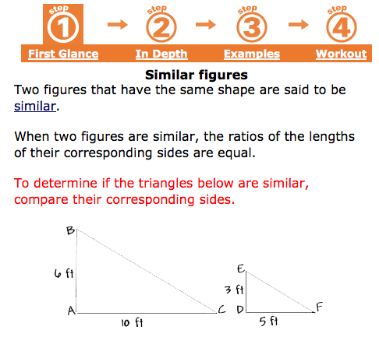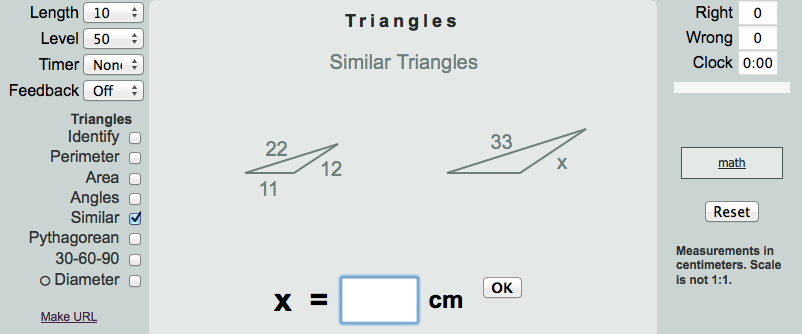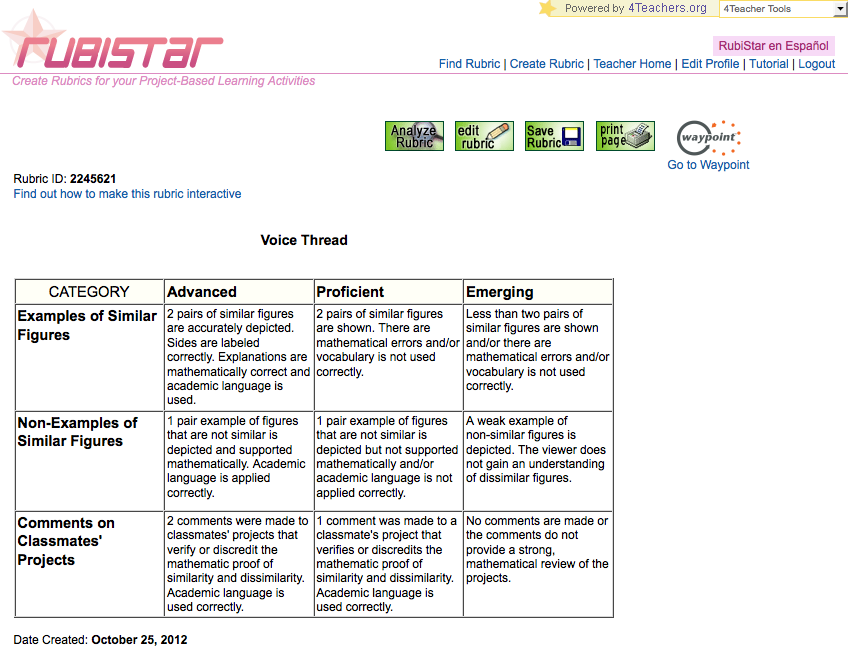In this assignment, I developed a comprehensive assessment plan for a lesson that can be taught in an online/blended environment or a classroom with access to computers. In the lesson, special focus is given to the frequency of formative assessments prior to the summative assessment. The emphasis on formative assessment ensures students receive adequate practice with feedback prior to their assessment of concept mastery. The lesson capitalizes on the ubiquitous web applications, incorporating online tutorials, applications, and assessment tools.
Common Core State Standards
5th Grade
Classify 2-D figures based on their properties and analyze patterns and relationships (similarity in the anticipatory set)
6th Grade
Understand ratio concepts and use ratio reasoning to solve problems (finding missing sides in the application problems)
Standards for Mathematical Practice
Attend to precision.
Reason abstractly and quantitatively.
Look for and make use of structure.
Goal
Students discover the meaning of
similarity, develop a definition using academic language, and formulate a
process to find missing sides of similar figures
Common misunderstandings
- Students add instead of multiplying when applying scale factors
- Students are not able to correctly identify corresponding sides of similar figures
- Students do not find and/or correctly apply the scale factor to all dimensions when creating similar figures


I created the rubric pasted below using one of my favorite websites, Rubistar. Here's a screen shot of the rubric on Rubistar's web site. Rubric created there can be saved indefinitely on their site, saved locally, or downloaded to Excel or Open Office for further modification. I use rubrics often to clearly communicate academic and behavior expectations to students.

Lesson Sequence
- Compare and Contrast
-
Students compare and contrast the polygons in the links below
- Compare these polygons {Click Here} to these polygons {Click Here}
- Write a discussion post that explains the difference between the shapes on the first page and the shapes on the second page
- Formative Assessment - Do students notice the difference between similar and congruent figures?
-
Feedback Method - Respond to posts to let students know they are on the right track or clear misconceptions.
-
Students compare and contrast the polygons in the links below
-
What does it mean for two shapes to be similar?
-
Students go to http://www.math.com/school/subject1/lessons/S1U2L4GL.html, take notes, and work through example problems
- In the online session, students will be split into breakout rooms.
- Small groups develop an academic and "plain English" definition of similar
- Students return to main room and share their definitions with peers. Students share misconceptions that were addressed by peers in the small group discussion. The whole class comes to consensus on an academic and "plain English" definitions
- Formative Assessment - Teacher moves through breakout rooms, listening to conversations and notes on target definitions and misconceptions
-
Feedback Method - Teacher uses guided questioning in small and whole group sessions
-
Students go to http://www.math.com/school/subject1/lessons/S1U2L4GL.html, take notes, and work through example problems
-
Guided Practice
- Instructor screen shares practice problems in this link: http://www.thatquiz.org/tq-A/?-jg-l1i-m2kc0-na-p0
- Instructor talks through a few problems then gradually releases problem solving to students. Students type answers in the chat box when she says "go" so that students don't rely on posted answers instead of generating their own
- Formative Assessment - Teacher notes misconceptions and adjusts level of difficulty and instruction as necessary. Teacher may review chat transcript after class
-
Feedback Method - Teacher
adjusts instruction in the session and contacts students individually if
necessary to address gaps in prior knowledge and/or check in with
students who display/exprss difficulty in the whole group session
-
Summative Assessment
- Students create a Voice Thread project that shows:
- Drawings of 2 pairs of figures that are similar with measurements for corresponding parts noted
- Description of method to find the measures of missing sides
- One pair of non-congruent figures and explain why they are not congruent
- Invite 2 classmates to comment on your work
- Invited students will comment on their peer's Voice Thread